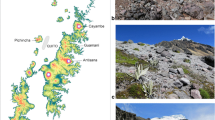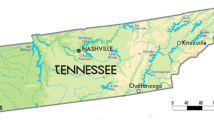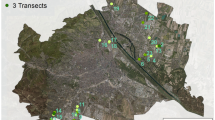Abstract
Although land snail communities could be a good indicator of soil quality and landscape structure impact, they are seldom analysed in an urban context, probably because of the lack of interest in this ecosystem and because no fast and reliable method of inter-site comparison seems to exist. The classical method of removing large quantities of soil leads to degradations unsuitable in urban gardens and involves time-consuming sorting. For the purpose of ecological comparisons, we analysed different methods to assess land snail communities in urban parks in order to set up a simplified strategy. Snail communities were sampled in three parks within the city of Paris (France) using (1) quadrat method (litter and soil removed over a given area, snails sorted later in the laboratory), (2) visual search in situ (hand-picking snails in the leaf litter), (3) wooden boards placed on the ground and regularly checked, and (4) pitfall traps, usually used for insect sampling. Our results suggest that the wooden board and pitfall trap did not yield enough data to determine community structure and that visual search was not sufficient to sample all dominant species, especially the smallest ones. In order to allow for replication of samples, we suggest a mixed strategy suitable for ecological comparisons, combining visual searches of five 0.5 m2 areas (15 min for each area) and litter and soil sampling on two 0.0625 m2 quadrats.


Similar content being viewed by others
References
Baur A, Baur B (1993) Daily movement patterns and dispersal in the land snail Arianta arbustorum. Malacologia 35:89–98
Bibby CJ, Burgess ND, Hill DA, Mustoe SH (2000) Bird census techniques. Academic Press, San Diego
Brault JP, Gervais M (2004) Les Mollusques du Loir-et-Cher Sologne. Nature Environnement rapport, Romorantin-Lanthenay
Cameron RAD, Pokryszko BM (2005) Estimating the species richness and composition of land mollusc communities: problems, consequences and practical advice. J Conchol 38:529–548
Colwell RK (2009) EstimateS: statistical estimation of species richness and shared species from samples. Version 8.2. User’s Guide and application published at http://purl.oclc.org/estimates
Cucherat X, Demuynck S (2008) Les plans d’échantillonnage et les techniques de prélèvement des mollusques continentaux. MalaCo 5:244–253
Dedov I, Penev L (2004) Spatial variation in terrestrial gastropod communities (Gastropoda, Pulmonata) along urban-rural gradients in Sofia City, Bulgaria. In: Penev L, Niemela J, Kotze DJ, Chipev N (eds) Ecology of the city of Sofia: species and communities in an urban environment. Pensoft, Sofia, pp 307–318
De Winter AJ, Gittenberger E (1998) The land-snail fauna of a square kilometre patch of rainforest in southwestern Cameroon: high species richness, low abundance and seasonal fluctuations. Malacologia 40:231–250
Fontaine B, Gargominy O, Neubert E (2007a) Priority sites for conservation of land snails in Gabon: testing the umbrella species concept. Divers Distrib 13:725–734
Fontaine B, Gargominy O, Neubert E (2007b) Land snail diversity of the savanna/forest mosaic in Lopé National Park Gabon. Malacologia 49:313–338
Gotmark F, Von Proschwitch T, Niklas F (2008) Are small sedentary species affected by habitat fragmentation? Local vs landscape factors predicting species richness and composition of land molluscs in Swedish conservation forests. J Biogeogr 35:1062–1076
Grimm B, Paill W (2001) Spatial distribution and home-range of the pest slug Arion lusitanicus. Acta Oecol 22:219–227
Hausdorf B (2007) The interspecific relationship between abundance and body size in central European land snail assemblages. Basic Appl Ecol 8:125–134
Horsák M (2003) How to sample mollusc communities in mires easily? Malacol Bohemoslovaca 2:11–14
Horsák M, Juřičková L, Kintrová K, Hájek O (2009) Patterns of land snail diversity over a gradient of habitat degradation: a comparison of three Czech cities. Biodivers Conserv 18:3453–3466
Hylander K, Nilsson C, Jonsson BG, Gothner T (2005) Differences in habitat quality explain nestedness in a land snail meta-community. Oikos 108:351–361
INPN (2009) Inventaire national du Patrimoine naturel. http://inpnmnhnfr
Kappes H, Jordaens K, Hendrickx F, Maelfait JP, Lens L, Backeljau T (2009) Response of snails and slugs to fragmentation of lowland forests in NW Germany. Landsc Ecol 24:685–697
Kerney MP, Cameron RAD (1979) A field guide to the land snails of Britain and North-West Europe. Collins, London
Kerney MP, Cameron RAD, Bertrand A (2006) Guide des escargots et des limaces d’Europe. Les guides naturalistes. Delachaux et Niestlé, Turin
Liew TS, Schilthuizen M, bin Lakim M (2010) The determinants of land snail diversity along a tropical elevational gradient: insularity, geometry and niches. J Biogeogr 37:1071–1078
Oggier P, Zschokke S, Baur B (1998) A comparison of three methods for assessing the gastropod community in dry grasslands. Pedobiologia 42:348–357
Raheem DC, Naggs F, Preece RC, Mapatuna Y, Kariyawasam L, Eggleton P (2008) Structure and conservation of Sri Lankan land-snail assemblages in fragmented lowland rainforest and village home gardens. J Appl Ecol 45:1019–1028
Suominen O (1999) Impact of cervid browsing and grazing on the terrestrial gastropod fauna in the boreal forests of Fennoscandia. Ecography 22:651–658
Suominen O, Edenius L, Ericsson G, Dios VR (2002) Gastropod diversity in aspen stands in coastal northern Sweden forest. For Ecol Manag 175:1–10
Tattersfield P (1998) Patterns of diversity and endemism in East African land snails and the implications for conservation. J Conchol 2:77–86
Triantis KA, Parmakelis A, Cameron RAD (2009) Understanding fragmentation: snails show the way. J Biogeogr 36:2021–2022
Valovirta I (1996) Land mollusc monitoring scheme. A handbook for field and laboratory methods. Finnish Environmental Institute Nordic Council of Ministers, Helsinki
Waldén HW (1981) Communities and diversity of land mollusc in Scandinavian woodlands. I. High diversity communities in taluses and boulder slopes in SW Sweden. J Conchol 30:351–372
Watters GT, Menker T, O’Dee SH (2005) A comparison of terrestrial snail faunas between strip-mined land and relatively undisturbed land in Ohio USA—an evaluation of recovery potential and changing faunal assemblages. Biol Conserv 126:166–174
Acknowledgments
We thank Alan Vergnes for his help on pitfall capture and pH data, Olivier Gargominy for his help on determination, and Gail Wagman who improved the English. We also thank the Malacology Laboratory of the National Museum of Natural History in Paris for its welcome. This study has been supported by a grant from Conseil Régional d’Ile-de-France.
Author information
Authors and Affiliations
Corresponding author
About this article
Cite this article
Clergeau, P., Tapko, N. & Fontaine, B. A simplified method for conducting ecological studies of land snail communities in urban landscapes. Ecol Res 26, 515–521 (2011). https://doi.org/10.1007/s11284-011-0808-5
Received:
Accepted:
Published:
Issue Date:
DOI: https://doi.org/10.1007/s11284-011-0808-5




